I’m obsessed with details, procedures, and efficiency. I like to be organized and optimized. While I was traveling, I was struck by how accessible the world is to a solo traveler in the 2020s, all thanks to modern technology. I may be alone out there, but I carry a god-like computer in my fanny pack. I can do hundreds of things with a smartphone that were unfathomable 20 years ago. I can do research, make reservations, traverse a city using public transport, track my spending by category, converse in languages I don’t know, learn a new language, entertain myself, and keep a journal of my adventures. I was also trying to be pretty frugal throughout my big trip.
There’s an app or a hack for all of that. Knowing how to optimize your phone makes travel shockingly easy. But figuring out the right tool for each task took some time. So this is my detailed 2024 guide for getting the most out of your device, including my favorite apps, tips about phone settings, and general best practices. I have an iPhone, so some of this info is specific to iOS, but most of it is applicable to everyone.
This list is organized chronologically from the perspective of travel planning and in order of importance. Some of the paid apps have referral incentives, so if you sign up for one of those through links I’ve posted, I’ll get a kickback. But this is all genuinely stuff that I use regularly and that I’d recommend.
The Essentials
#1 Hot Tip: Back up your data.
I know several people who’ve lost everything when their phone got stolen or destroyed. When you’re traveling, this is twice as sad and twice as inconvenient. Put your photos in the cloud. Pay for it if you don’t have enough free storage. Having general cloud backup also means that you can restore everything from your lost phone on a new device. Related: If you have an iPhone, double check that you have Find My iPhone turned on, with access to location services.
Password Manager
I currently use Keeper (here’s a 30% discount), but there are a lot of others to choose from, some are free. This is the best way to make sure you can access all of your accounts no matter where you are in the world, even if your computer and phone get stolen. If you’re still writing passwords down on paper or in a spreadsheet, or you’re using the same password for multiple things, it’s time to get a password manager. It’s life-changing. Whether or not you’re traveling, you should use one. You can also store other sensitive stuff like photos of your credit cards, passport, etc. I went into some detail about this in my post about packing. But suffice it to say, you should have securely cloud-stored photos of all your cards and important documents.
eSIMs
This is how to have cell service abroad without spending a fortune. You can purchase a data-only plan for whatever country or region you’re planning to visit. They sell options for periods from a few days to a few months. Your phone needs to be unlocked/jailbroken, but newer phones all come that way.
Make sure your regular number is on an eSIM too. You should be able to set this up from your online account with your carrier. This way you can switch out the physical SIM chip without worrying about misplacing your main one. When you leave the country, turn off your regular number, and turn off cellular data switching to avoid roaming charges.
Airalo has the cheapest eSIMs I’ve found (here’s $3 off). I think Airalo is the best option if you’re in a country for a short time. It’s great to have data as soon as you land, for a fraction of the daily fee that your carrier would charge. If you’re staying somewhere for more than a week, I still think it’s worth it to get an Airalo eSIM to help you get from the airport to your accommodation and get settled for the first few days with no stress. Then, it’s good to go buy a physical local SIM, just Google which carrier has the best service.
To conserve data on a limited plan, go to cellular data settings and turn off app access for all but the absolute essentials. You can look at which apps are consuming the most data and turn off their access. Instagram and YouTube will eat all your data, use these only on WiFi. When I’m in data austerity mode, I only use data for maps, my browser, translation, and messaging apps. It’s also important to turn off Wifi Assist, which will use data if wifi is weak. Data austerity success stories: I did 4 months in Europe with less than 30 gigs. One week in Panama on one gig. Bonus: being super data use-conscious results in spending less mindless time on your phone.
Related: I use an app called OffScreen to limit my time on social media. I pay for it, it’s like $5 annually.
VPN
To avoid consuming lots of data, you’re going to use a lot of free WiFi. Protect yourself from sketchy networks and stolen information by using a VPN. Also, if you’re entering personal info or credit card info, it’s better to disconnect from WiFi networks and use data. I use Private Internet Access because it’s the cheapest one available with a year-long subscription, but to be honest, it’s not great. There are plenty with better ratings that don’t cost that much more.
Messaging Apps
At least in Latin America, WhatsApp is used more than regular text messages and phone calls. It’s the preferred app for communication for businesses. I’ve booked tours, transportation, and even doctor appointments on WhatsApp.
I have a Google Voice number (easy to set up with your Google account), and I use it to send text messages to people in the US using data. This is the way I send texts to people who don’t have WhatsApp or another messaging app. I can also log in to Google Voice on my computer to place phone calls to US numbers, which is particularly helpful when I need to deal with anything administrative.
iMessage works for iPhones internationally on WiFi and on data. So even when my US phone number is turned off, I can use iMessage to send texts.
Accommodation
All of these accommodation apps work just fine in a browser. I just like having the apps because they have a nicer interface when you’re using a mobile device. And you can turn on notifications, so if you’re communicating with a hostel or host, you can see their messages promptly.
Booking
As a solo traveler, Booking is my go-to accommodation app. It has a great search function, which allows you to find the best-for-the-money option. My friend Juleun taught me the following method for searching in a given location: Filter out any accommodations not rated 8/10 or above. Then sort these results by lowest price first. When I’m alone, I’m pretty much always a hostel dorm person. I wrote some tips about how to find the best hostel dorm a while back.
Hostelworld
I don’t use Hostelworld as much. It’s pretty similar to Booking, but I think the search function isn’t as good. I still think it’s good to double-check. Once in a while, you find the same hostels listed for less or places that have a listing on one platform but not the other.
Airbnb
There are some places where Airbnbs are your cheapest option. Even cheaper than a hostel dorm. This is especially true if you’re traveling with another person. If other accommodation seems expensive, be sure to check Airbnb.
Workaway
Workaway is not strictly an accommodation app. It’s a platform that helps connect volunteers with work-exchange opportunities. Usually 25 hours a week in exchange for room and board. I used Workaway a few times during my trip, and I had some of my favorite travel experiences through this platform. Workaways are better to coordinate well in advance. It can be a bit of a flaky culture… you might send out 15 messages and get 3 replies. Read the reviews carefully. Write your profile carefully. You pay an annual membership of about $35.
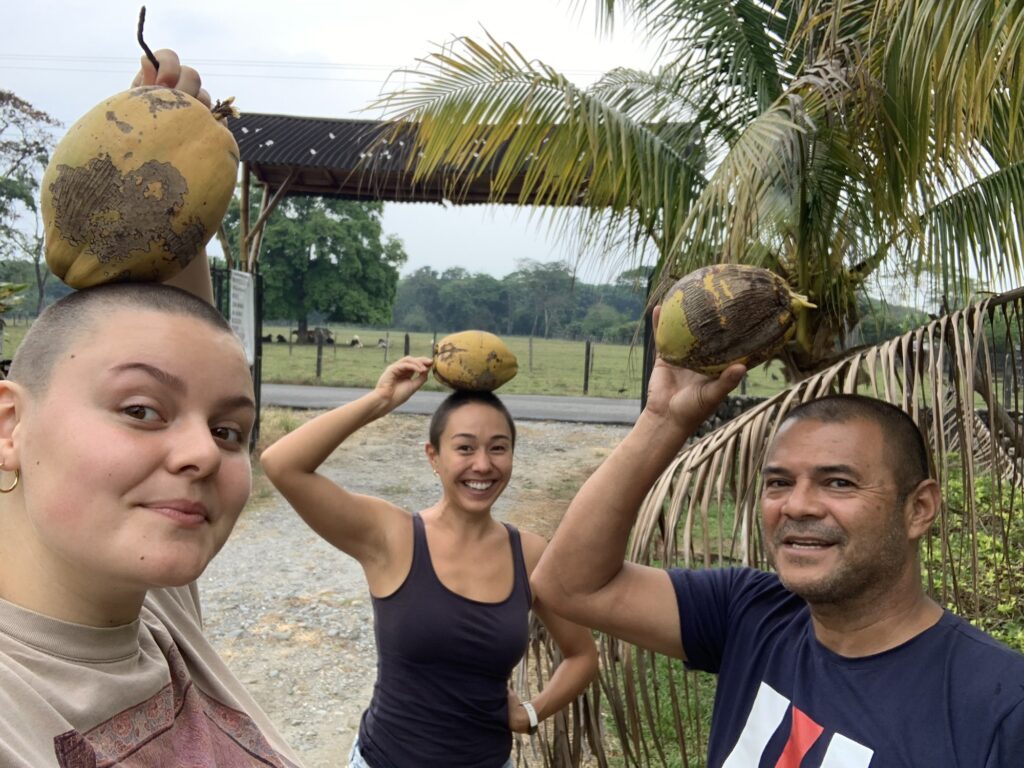
Getting from A to B
Airline Apps
I keep the app of whichever airline I’m using soon loaded on my phone and delete it later. While you have access to most of the same functions through your browser, the apps usually streamline the process for check-in and flight tracking. You can also sometimes save your passport, frequent flyer, and credit card info. Make sure to download or screenshot your boarding passes ahead of time. I’ve been in airports where the wifi doesn’t work and there’s no cell reception.
And don’t forget, even if you’ve checked in online and received a boarding pass, for international flights, you still need to wait in line and show your passport at the check-in desk. I’ve forgotten to do this and had some very stressful times as a result.
Before you depart, check the entry requirements for the country you’re going to visit. You might also need to show “proof of onward travel” in the form of a plane ticket leaving the country (bus or ferry tickets do not suffice). The airlines are in charge of enforcing this border control regulation, and you may be denied check-in if you don’t have this ticket. If you’re not sure when you’ll be leaving, there are some easy workarounds for proof of onward travel.
TripIt
By filtering through your email inbox, TripIt can aggregate all your reservations (flights, trains, accommodations, tours) into a single timeline. This gives you easy access to dates, booking codes, etc, all in one place. For security, you can also share this timeline with your trusted family or friends so they know where you’ll be.
Related: I also share my location constantly with my parents through my iPhone settings. It’s a good security measure to take if you’re traveling solo.
Google Maps
I use a combination of navigation apps. Google is my go-to for walking directions and time estimates. It also has some public transit info but only the schedules, though no real-time tracking.
But my favorite use for Google Maps is creating my personal map for every place I visit. I create a new saved map, and pin all of the places I might want to visit, my accommodation, restaurants I enjoy, etc. Then I can easily look at the map to plan out my days based on where things are located. It’s also a great resource if you want to share your recommendations with someone who will be visiting the same place.
Rome2Rio
Rome2Rio is what I use to figure out how to get anywhere that I can’t walk. It’s particularly useful if you need to travel between cities, or if you need to use a combination of different modes of transit. It’ll show you where the train and bus stations are and which transport companies travel to which destinations. But it’s not super detailed with schedules. Sometimes I just use it to get a general idea and start planning. Then I use another app or website to actually purchase tickets.
Redbus
Redbus is good for comparing bus schedules and buying tickets directly.
Citymapper
Citymapper is one of my favorite tools on this list. It helps you to compare routes, mixed methods of transit, prices, and travel duration. It gives step-by-step directions for navigating public transport, including real-time stop-by-stop tracking, guidance for transfers, and notifications when it’s time to get off the bus or metro. I completely prefer it over Rome2Rio, but the downside is that this app only works in certain big cities.
Uber
Uber doesn’t work everywhere, but it’s always worth checking, and I use it whenever I can. There are some countries and cities where taxis will try to rip you off, or where you need to negotiate prices instead of just having a standard metered rate, and I prefer to just skip that hassle. Even though Uber has had its share of very publicized safety issues, I think it’s always better to ride with an app with an accountability mechanism in the form of reviews and reporting.
I also sometimes use other taxi or rideshare apps. In places that don’t have Uber, there are often other taxi apps that work similarly. Google what’s available where you’re going.
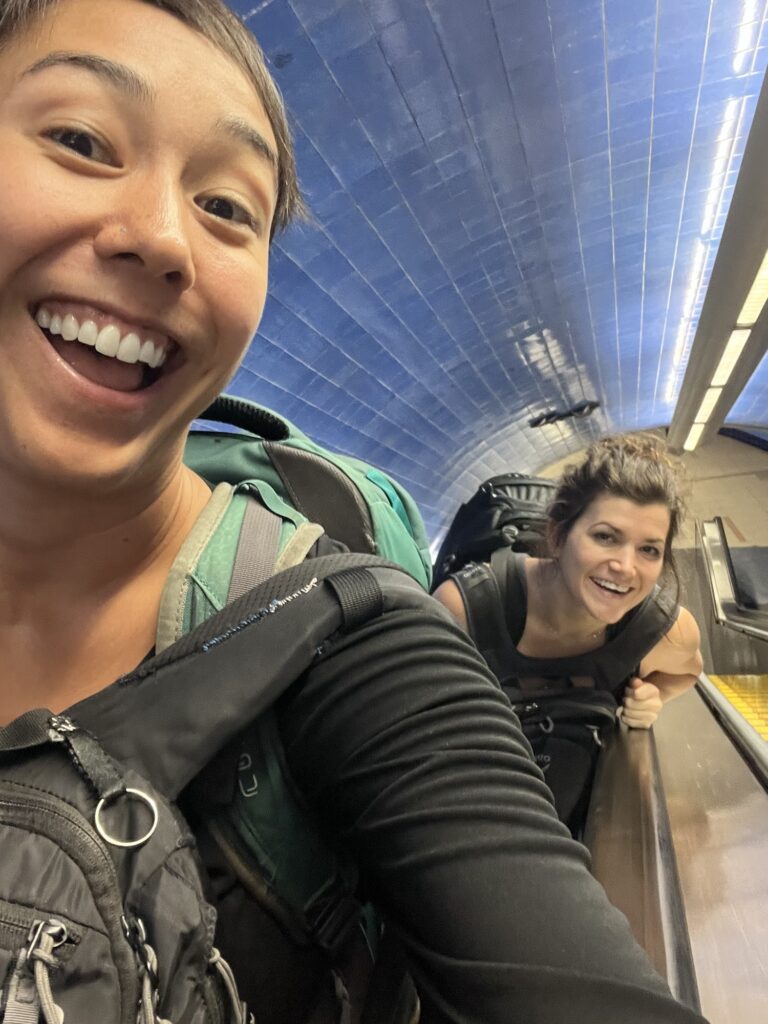
Finance
Currency Converter
I’ve used a lot of different currencies in the last couple of years, and it can be difficult to adjust your brain to thinking about prices in a new currency. I always like to compare prices and convert them to dollars to make sure I’m not overspending or getting ripped off. The app I use is called My Currency Converter & Rates, but I think any app with good reviews will work fine.
Related: Never, ever exchange cash at the airport. They charge astronomical fees. It’s better to just go to the ATM to withdraw local currency. If you can, find a card that refunds your ATM fees. IMPORTANT: When you go to an ATM, it will often offer you the option to “accept or decline conversion”. Always decline. This is the exchange rate offered by the foreign bank, and it’s separate from the fee to use the ATM. Your own bank will always give you a better exchange rate. The ATM will charge you 6-10% extra, which adds up fast.
Credit Card and Bank Apps
Many of the places I visited have pretty cash-heavy economies, but I use my credit card whenever I can so I can get points and protections. If someone who is taking your credit card payment asks you whether you want to pay in the local currency or your home currency, always choose the local currency. This is another place where card processors can charge you their inflated conversion rate and take more money from you.
I keep the apps for my credit cards and bank accounts loaded on my phone so I can easily review my transactions. You can also lock your cards easily from the app if they get stolen. Related: Notify your bank and card carriers that you’ll be traveling in order to avoid declined transactions.
Mint
For the last decade, I’ve been tracking all my spending, income, and investments with Mint. It’s connected to my bank accounts and cards and creates reports of my spending and income over time and by category. You have to manually add cash transactions, and it’s important to be on top of that so you can have accurate reports. Mint’s parent company Intuit recently acquired Credit Karma, so as of the writing of this post, they’re closing Mint and moving over to Credit Karma.
EDIT March 6, 2024: The Credit Karma app sucks. Most of the app is just an ad for various finance products, and though it does connect to your financial institutions to track spending through linked accounts, there’s no way to manually add transactions (necessary in a country where you are spending mostly in cash), and the budgeting features are sorely lacking. Do not recommend.
I’ve been doing some research to figure out what to use now that Mint is gone. YNAB (You Need a Budget) is super popular and well reviewed, but after a decade of using Mint for free, the frugal backpacker in me does not like the price tag. Empower sounds like a decent option and is free like Mint, but from what I’ve heard, they don’t do a great job with transaction categorization. I just learned about a new app called Piere, which is currently only available for iOS, and early users get a lifetime free membership (Android users can get in on this by signing up for their notifications of the Android release). It also has the option to upload your CSV of historical Mint transactions, which is huge for me. So I’ll be trying that out.
Splitwise
If you’re doing activities with friends and are splitting up costs, Splitwise is a tool that keeps everything organized and does the math for you. Arithmetic is not my strong suit, so I’ve found it super useful.
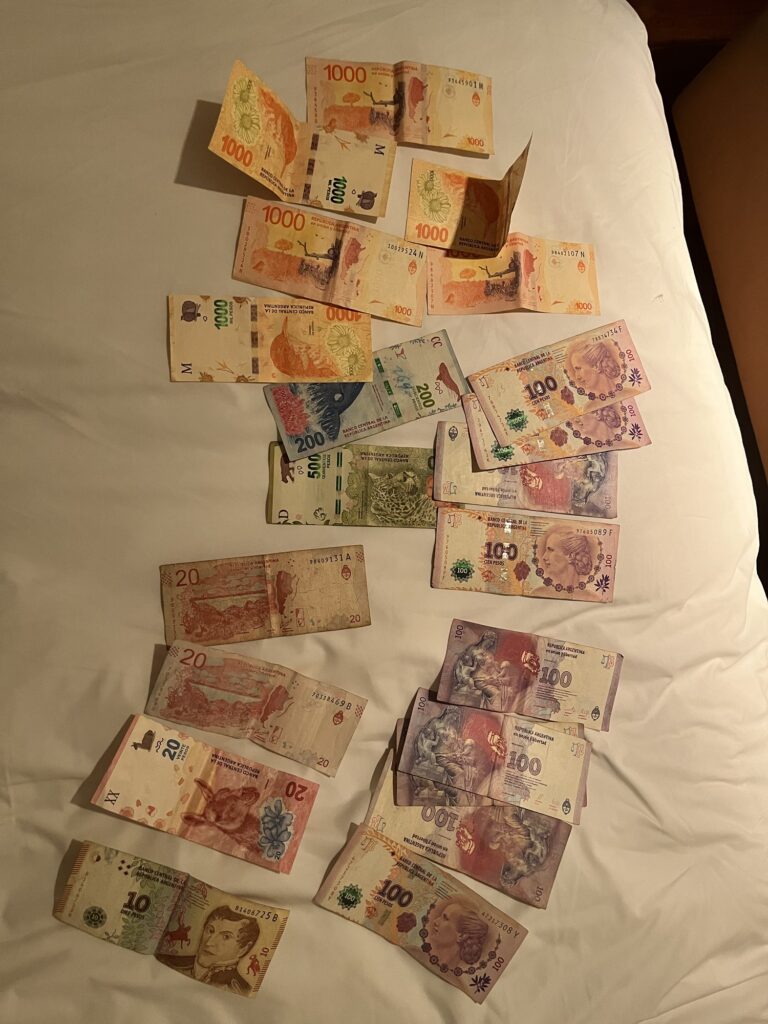
Language
Reverso Contexto
Reverso Contexto is my favorite translation app because it gives you contextual examples from the web, which is very useful for colloquialisms. It also saves your recent searches so you can look back at them and add them to vocabulary lists if you’re learning a language. You can also download a dictionary for offline use. The available languages are more limited than some other apps, however.
DeepL
DeepL was recommended by a lot of people for being more accurate with translation subtleties than Google Translate, with a lot of the same features, such as photo text recognition. It also has more languages than Reverso Contexto.
(Google) Translate
Translate is the best for obscure languages like Albanian. You can use it as a conversational intermediary by speaking English into the microphone, and it’ll produce speech in another language, which is super cool.
Flashcard App
Anki is a spaced repetition flashcard app, which I use for learning Spanish vocabulary. Spaced repetition is a proven method for memorizing information by reviewing it at optimal intervals. Honestly, the app interface isn’t my favorite, and the iPhone version was super expensive (Android and web versions are free). Other spaced repetition apps are probably better, and many are free.
Duolingo and Language Transfer
Almost 4 years since I first started learning Spanish on Duolingo, I still use the app almost every day. I’m almost finished with the Spanish course. Though it has its limitations, I still think it’s a great tool. I wrote more about Duolingo and another language learning app called Language Transfer in a previous blog post.
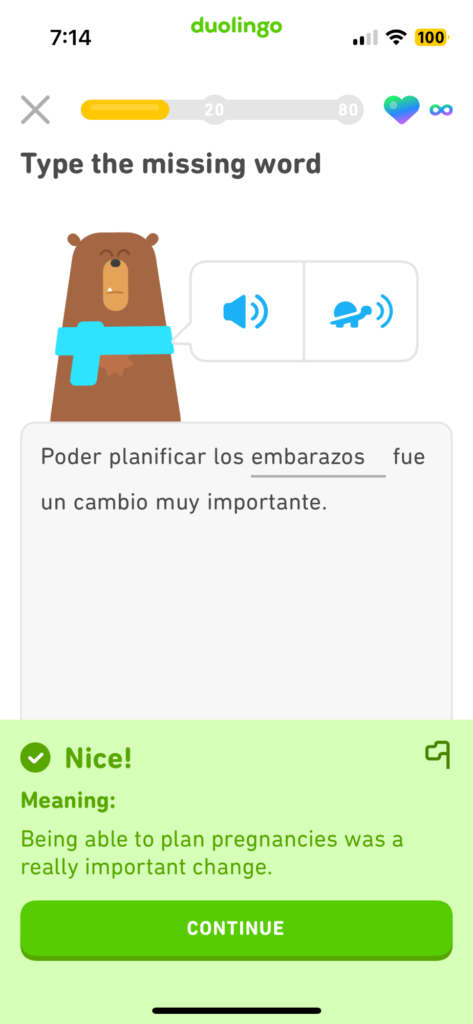
Journaling
1 Second Every Day
With 1SE, you can upload a second of video every day of your trip. It’s easy, and makes for a cool visual journal that immediately takes you back to some of your favorite memories.
Polarsteps
I wish I’d used Polarsteps for my whole trip, mostly because the map it creates is really cool. The easiest way to use it is to let it use data to automatically prompt you when you’ve changed locations, and I had cellular data turned off for this app (see my notes on austerity mode above). But you can also just post updates while you’re on WiFi.
Perspective
I prefer writing in a physical journal, but if that’s not your cup of tea, Perspective is a good alternative, and its habit-tracking feature is a great way to keep yourself accountable to your daily goals.
For Fun
Libby
If you have a library card, your library probably gives you access to digital resources using Libby or something similar. This is the perfect resourceK if you like audiobooks or have a kindle. The only downside is that there are sometimes long wait lists for particular titles, but hey, it’s free.
Audible
Audible is Amazon’s audiobook app, and you need to pay for membership. But here’s a secret hack: you can log in to any account on your device, download everything you want, then log out, and the content will stay on there. And then log in to a different account and do it again.
Merlin Bird ID
Merlin was produced by the ornithology lab at Cornell University, and even though I am a very novice birder (if I can even be called that), I find it so fun to use. It’s like bird Shazam! You can record audio of bird calls, and the app will use AI to tell you which bird it is. You can also ID birds from photos or descriptions.
AllTrails
Though it admittedly has better trail information within the US, AllTrails is a useful tool for planning a hike. If you hike a lot while you travel, it might be worth paying for the premium version of AllTrails, which lets you download maps for use when you have no cell reception. This saved me and some friends when we got lost on a big hike in Colombia.
Happy Cow
Vegetarian and vegan food can be harder to find in some parts of the world. Happy Cow shows you your nearby options, including reviews.
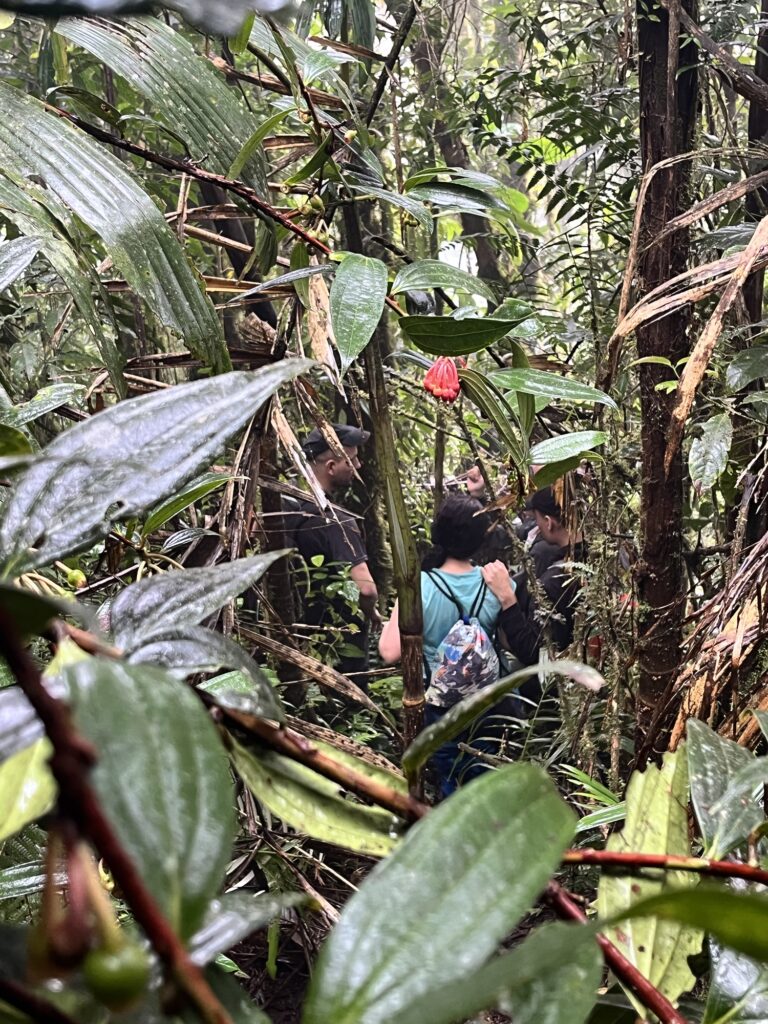

I’ve never heard of Citymapper, Offscreen or Merlin but I’m checking them out now. Thanks, Sachi!
Also I’m working on a website that needs to be translated for a client, and you better believe I’m gonna recommend that we try DeepL before Google Translate. Great pointers as always!
So glad it’s useful info for you! And I’m curious to know what kind of birds you find close to home, Merlin is so much fun!